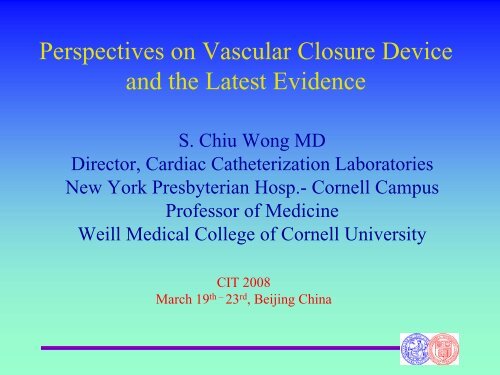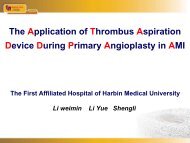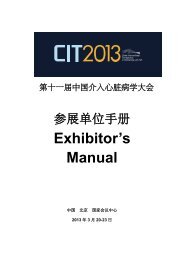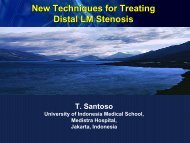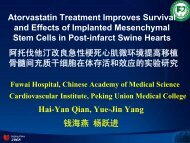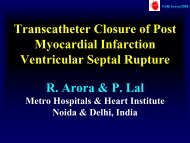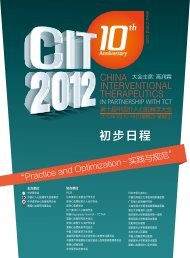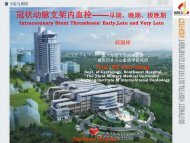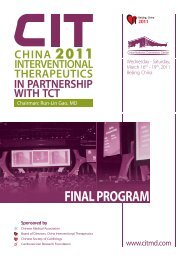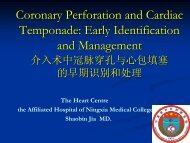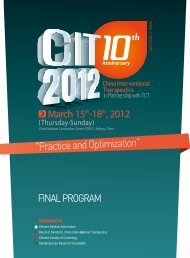Perspectives on Vascular Closure Device and the Latest Evidence
Perspectives on Vascular Closure Device and the Latest Evidence
Perspectives on Vascular Closure Device and the Latest Evidence
You also want an ePaper? Increase the reach of your titles
YUMPU automatically turns print PDFs into web optimized ePapers that Google loves.
<str<strong>on</strong>g>Perspectives</str<strong>on</strong>g> <strong>on</strong> <strong>Vascular</strong> <strong>Closure</strong> <strong>Device</strong><br />
<strong>and</strong> <strong>the</strong> <strong>Latest</strong> <strong>Evidence</strong><br />
S. Chiu W<strong>on</strong>g MD<br />
Director, Cardiac Ca<strong>the</strong>terizati<strong>on</strong> Laboratories<br />
New York Presbyterian Hosp.- Cornell Campus<br />
Professor of Medicine<br />
Weill Medical College of Cornell University<br />
CIT 2008<br />
March 19 th – 23 rd , Beijing China
ECLIPSE Trial<br />
Presenter Disclosure<br />
• S. Chiu W<strong>on</strong>g MD<br />
C<strong>on</strong>sultant: Cordis JNJ, Medtr<strong>on</strong>ics, Abott <strong>Vascular</strong><br />
Member, Advisory Board: Cordis JNJ, Medtr<strong>on</strong>ics,<br />
Abott <strong>Vascular</strong><br />
Clinical Trial Grants: Bost<strong>on</strong> Scientific, Cordis JNJ,<br />
Medtr<strong>on</strong>ics, Abott <strong>Vascular</strong>
<str<strong>on</strong>g>Perspectives</str<strong>on</strong>g> <strong>on</strong> <strong>Vascular</strong> <strong>Closure</strong> <strong>Device</strong><br />
Summary<br />
• Historical Perspective: Background & Rati<strong>on</strong>ale<br />
• Current Perspective: Current <strong>Device</strong>s & <strong>Evidence</strong><br />
• Future Perspective: Selective New <strong>Device</strong>s<br />
• C<strong>on</strong>clusi<strong>on</strong>s: Role of <strong>Vascular</strong> <strong>Closure</strong> <strong>Device</strong>s
<str<strong>on</strong>g>Perspectives</str<strong>on</strong>g> <strong>on</strong> <strong>Vascular</strong> <strong>Closure</strong> <strong>Device</strong><br />
• Historical Perspective: Background & Rati<strong>on</strong>ale<br />
• Current Perspective: Current <strong>Device</strong>s & <strong>Evidence</strong><br />
• Future Perspective: Selective New <strong>Device</strong>s<br />
• C<strong>on</strong>clusi<strong>on</strong>s: Role of <strong>Vascular</strong> <strong>Closure</strong> <strong>Device</strong>s
<str<strong>on</strong>g>Perspectives</str<strong>on</strong>g> <strong>on</strong> <strong>Vascular</strong> <strong>Closure</strong> <strong>Device</strong><br />
“Ca<strong>the</strong>ter Replacement of <strong>the</strong> Needle in Percutaneous Arteriography; a new Technique”<br />
2008 marks <strong>the</strong> 55 TH anniversary of Seldinger’s seminal<br />
work <strong>on</strong> percutaneous approach in ca<strong>the</strong>terizati<strong>on</strong><br />
a) The artery punctured.<br />
The needle pushed<br />
upwards. b) The leader<br />
inserted. c) The needle<br />
withdrawn <strong>and</strong> <strong>the</strong> artery<br />
compressed. d) The<br />
ca<strong>the</strong>ter threaded <strong>on</strong>to <strong>the</strong><br />
leader. e) The ca<strong>the</strong>ter<br />
inserted into <strong>the</strong> artery. f)<br />
<strong>the</strong> leader withdrawn<br />
Seldinger SI Acta Radiol 1953; 39: 368–76.
<str<strong>on</strong>g>Perspectives</str<strong>on</strong>g> <strong>on</strong> <strong>Vascular</strong> <strong>Closure</strong> <strong>Device</strong>s<br />
Impact of Access Site Complicati<strong>on</strong>s: Patient’s Perspective<br />
No matter how Good a job you did<br />
for <strong>the</strong> cor<strong>on</strong>aries,<br />
this is a Bad procedure!<br />
No matter what kind of a job you<br />
did for <strong>the</strong> patient’s cor<strong>on</strong>aries,<br />
this is a Good procedure!
<str<strong>on</strong>g>Perspectives</str<strong>on</strong>g> <strong>on</strong> <strong>Vascular</strong> <strong>Closure</strong> <strong>Device</strong>s<br />
Access Site Complicati<strong>on</strong>s Associated w/ Invasive Procedures<br />
<strong>Vascular</strong> complicati<strong>on</strong> rates ranged from 0.5% 1,3 to as high as 27% 2 (diagnostic<br />
& interventi<strong>on</strong>al) were reported following invasive cor<strong>on</strong>ary procedures.<br />
• Hematoma<br />
• AV fistula<br />
• Pseudoaneurysm<br />
• Infecti<strong>on</strong><br />
• Retroperit<strong>on</strong>eal Bleed<br />
• Dissecti<strong>on</strong> & Thrombosis<br />
• Nerve Damage<br />
• Late Perivascular Scarring<br />
• MI, Death sec<strong>on</strong>dary to bleeding & infecti<strong>on</strong><br />
1 Hoffer <strong>and</strong> Bloch. JVIR 2003;14: 865-885, 2 Kussmaul et al, JACC 1995;7: 1685-92,<br />
3 Dauerman HL et al JACC 2007;50:1617-26
<str<strong>on</strong>g>Perspectives</str<strong>on</strong>g> <strong>on</strong> <strong>Vascular</strong> <strong>Closure</strong> <strong>Device</strong><br />
An Ugly Groin Can have More Implicati<strong>on</strong>s than Just Pt Dissatisfacti<strong>on</strong>!<br />
You could have spent a few hours to open a CTO perfectly,<br />
if this happened at <strong>the</strong> procedure, this is Bad for <strong>the</strong> patient<br />
both in <strong>the</strong> short <strong>and</strong> l<strong>on</strong>g run!
<str<strong>on</strong>g>Perspectives</str<strong>on</strong>g> <strong>on</strong> <strong>Vascular</strong> <strong>Closure</strong> <strong>Device</strong>s<br />
Attributable Cost of <strong>Vascular</strong> Complicati<strong>on</strong>s<br />
In a cost-minimizati<strong>on</strong> study comparing routine AngioSeal versus<br />
mechanical compressi<strong>on</strong> involving 3,943 PCI pts from 1/02 to 12/04 at<br />
<strong>the</strong> Brigham & Women’s Hospital…<br />
Complicati<strong>on</strong>s<br />
Attributable Cost<br />
Hematoma $1339<br />
Arterio-venous fistula $1415<br />
Access Site Infecti<strong>on</strong> $5127<br />
Bleeding $5440<br />
Acute limb ischemia $5534<br />
Pseudoaneurysm $6357<br />
Retroperit<strong>on</strong>eal hemorrhage $6698<br />
Resnic F et al; Am J Cardiol 2007;99:766-770
<str<strong>on</strong>g>Perspectives</str<strong>on</strong>g> <strong>on</strong> <strong>Vascular</strong> <strong>Closure</strong> <strong>Device</strong>s<br />
Independent Predictors of 1-Year Mortality Post PCI<br />
Using <strong>the</strong> combined database <strong>on</strong> 5,384 patients from 4 r<strong>and</strong>omized placeboc<strong>on</strong>trolled<br />
trials (ISAR-REACT, -SWEET, -SMART-2, <strong>and</strong> –REACT-2 )…..<br />
Hazard Ratio (95%<br />
Variable<br />
p Value<br />
C<strong>on</strong>fidence Interval)<br />
Bleeding within 30 days 2.96 (1.96–4.48)
<str<strong>on</strong>g>Perspectives</str<strong>on</strong>g> <strong>on</strong> <strong>Vascular</strong> <strong>Closure</strong> <strong>Device</strong>s<br />
O<strong>the</strong>r Access-Site Related limitati<strong>on</strong>s in Invasive Procedures<br />
• Discomfort Associated with Sheath Removal<br />
• Inability to Tolerate Prol<strong>on</strong>ged Supine Positi<strong>on</strong> in<br />
Selected Patients due to a Variety of Co-morbid<br />
C<strong>on</strong>diti<strong>on</strong>s Including:<br />
Genital Urinary Problems (e.g. BPH)<br />
Spinal Stenosis<br />
C<strong>on</strong>gesti<strong>on</strong> Heart Failure<br />
Severe COPD<br />
Severe Valvular Disease<br />
Patients with Various Mental Disable C<strong>on</strong>diti<strong>on</strong>s
<str<strong>on</strong>g>Perspectives</str<strong>on</strong>g> <strong>on</strong> <strong>Vascular</strong> <strong>Closure</strong> <strong>Device</strong>s<br />
Rati<strong>on</strong>ale for Development of Access Site <strong>Closure</strong> <strong>Device</strong>s<br />
• Minimize Patient Discomfort Associated with<br />
Sheath Removal<br />
• Reduce <strong>the</strong> Need for L<strong>on</strong>g Recumbent<br />
Positi<strong>on</strong> Following procedure<br />
• Decrease <strong>the</strong> Time to Ambulati<strong>on</strong><br />
• Increase Cath Lab Throughput<br />
• Shorten Time to Potential Hospital Discharge
<str<strong>on</strong>g>Perspectives</str<strong>on</strong>g> <strong>on</strong> <strong>Vascular</strong> <strong>Closure</strong> <strong>Device</strong><br />
• Historical Perspective: Background & Rati<strong>on</strong>ale<br />
• Current Perspective: Current <strong>Device</strong>s & <strong>Evidence</strong><br />
• Future Perspective: Selective New <strong>Device</strong>s<br />
• C<strong>on</strong>clusi<strong>on</strong>s: Role of <strong>Vascular</strong> <strong>Closure</strong> <strong>Device</strong>s
<str<strong>on</strong>g>Perspectives</str<strong>on</strong>g> <strong>on</strong> <strong>Vascular</strong> <strong>Closure</strong> <strong>Device</strong>s<br />
Percutaneous Cor<strong>on</strong>ary/Peripheral Procedure L<strong>and</strong>scape<br />
• 9.577 MM Worldwide procedures<br />
(interventi<strong>on</strong>s <strong>and</strong> diagnostic procedures for<br />
both cor<strong>on</strong>ary <strong>and</strong> peripheral)<br />
• 5.681 MM US procedures (interventi<strong>on</strong>s <strong>and</strong><br />
diagnostic procedures for both cor<strong>on</strong>ary <strong>and</strong><br />
peripheral)<br />
• Global VCD Penetrati<strong>on</strong> Rate: 38%<br />
• US VCD Penetrati<strong>on</strong> Rate: 55%<br />
Projected for 2008 based <strong>on</strong> Millennium Research Group 2007 report
<str<strong>on</strong>g>Perspectives</str<strong>on</strong>g> <strong>on</strong> <strong>Vascular</strong> <strong>Closure</strong> <strong>Device</strong>s<br />
Current <strong>Closure</strong> <strong>Device</strong>s<br />
• Passive External Compressi<strong>on</strong>:<br />
Mechanical: C-Clamp, FemoStop<br />
Patch Mediated Manual: Syvek, Chito-Seal, HemC<strong>on</strong><br />
• Passive Temporary Indwelling:<br />
Pro-coagulant Al<strong>on</strong>g Tissue Track: Boomerang<br />
• Active <strong>Device</strong> Mediated:<br />
Suture Based: Perclose<br />
Collagen Based: Angio-Seal, VasoSeal<br />
Syn<strong>the</strong>tic Biosealant Based: Mynx<br />
Gel/foam Based: Duett, QuickSeal<br />
Staple Based: StarClose, Angiolink
<str<strong>on</strong>g>Perspectives</str<strong>on</strong>g> <strong>on</strong> <strong>Vascular</strong> <strong>Closure</strong> <strong>Device</strong>s<br />
US VCD Market by <strong>Device</strong> Q307<br />
Source: Millennium Research Group
<str<strong>on</strong>g>Perspectives</str<strong>on</strong>g> <strong>on</strong> <strong>Vascular</strong> <strong>Closure</strong> <strong>Device</strong>s<br />
Penetrati<strong>on</strong> of <strong>Vascular</strong> <strong>Closure</strong> Market<br />
• Although most of <strong>the</strong> currently<br />
available access site closures devices<br />
have reduced time to ambulati<strong>on</strong> <strong>and</strong><br />
hemostasis with similar complicati<strong>on</strong><br />
rates compared to manual<br />
compressi<strong>on</strong>, <strong>the</strong> adopti<strong>on</strong> rate is<br />
relatively low due to limitati<strong>on</strong>s<br />
associated with <strong>the</strong>se devices
<str<strong>on</strong>g>Perspectives</str<strong>on</strong>g> <strong>on</strong> <strong>Vascular</strong> <strong>Closure</strong> <strong>Device</strong>s<br />
Collagen Based Homeostasis <strong>Device</strong>s: Meta-analysis<br />
Medline search from 1990 <strong>on</strong> (to ?97), a total of 6007 pts received<br />
Vasoseal or AngioSeal for access site <strong>Closure</strong> in c<strong>on</strong>trolled studies..<br />
Minor**<br />
Complicati<strong>on</strong>s<br />
Major*<br />
Complicati<strong>on</strong>s<br />
VasoSeal<br />
VasoSeal<br />
C<strong>on</strong>trol<br />
Angio-Seal<br />
Angio-Seal<br />
C<strong>on</strong>trol<br />
7.6% 5.7% 6.7% 11.7%*<br />
3.8% 1.7%* 1.8% 1.4%<br />
* Difference is significant<br />
*Major : thrombosis or loss of distal pulses, larger<br />
pseudoaneurysm or AV fistula, <strong>and</strong> bleeding with need for<br />
transfusi<strong>on</strong> or surgery.<br />
**Minor: bleed not require transfusi<strong>on</strong> or surgery <strong>and</strong> small<br />
pseudoaneurysm treated medically Silber S. AHJ 1998 Jan;135:152-6.
<str<strong>on</strong>g>Perspectives</str<strong>on</strong>g> <strong>on</strong> <strong>Vascular</strong> <strong>Closure</strong> <strong>Device</strong>s<br />
Clevel<strong>and</strong> Clinic: Perclose Versus Angio-Seal<br />
Manual<br />
(N=2099)<br />
Angio-Seal<br />
(N=411)<br />
Perclose<br />
(N=408)<br />
P value<br />
Hematoma ≥5cm(%) 1.4 1.5 1.0 0.8<br />
AV Fistula(%) 0.7 0 0.2 0.13<br />
Pseudoaneurysm(%) 0.9 0.5 0.7 0.29<br />
Retroperit<strong>on</strong>eal Bl (%) 0.1 1.0 0.8 0.01<br />
Transfusi<strong>on</strong> (%) 0.8 1.2 1.7 0.16<br />
<strong>Vascular</strong> Occlusi<strong>on</strong> (%) 0.3 0.2 0 0.49<br />
Infecti<strong>on</strong> (%) 0 0 0.5 0.02<br />
<strong>Vascular</strong> Surgery (%) 0.4 0.2 1.0 0.25<br />
All Complicati<strong>on</strong>s (%) 3.1 2.9 3.2 0.96<br />
Cura et al, AJC 2000;86:780-782
<str<strong>on</strong>g>Perspectives</str<strong>on</strong>g> <strong>on</strong> <strong>Vascular</strong> <strong>Closure</strong> <strong>Device</strong>s<br />
<strong>Vascular</strong> complicati<strong>on</strong>s* by access site hemostasis strategy<br />
From 1/98 to 12/99, 3027 pts underwent PCI at Brigham Hosp. &<br />
eligible for VCD placement, 49.1% received VCD at <strong>the</strong> discreti<strong>on</strong> of<br />
<strong>the</strong> operator [89.8% AngioSeal, 7.3% Vasoseal, 3% Prostar].<br />
<strong>Vascular</strong> Complicati<strong>on</strong>s<br />
*<strong>Vascular</strong> complicati<strong>on</strong>s included need for surgical repair, transfusi<strong>on</strong>,<br />
development of arteriovenous fistula, pseudoaneurysm, or large hematoma<br />
Resnic FS et al AJC 2001;88:493-6
<str<strong>on</strong>g>Perspectives</str<strong>on</strong>g> <strong>on</strong> <strong>Vascular</strong> <strong>Closure</strong> <strong>Device</strong>s<br />
Meta-analysis: VCDs Vs. MC Post Percutaneous Procedures<br />
By systemically searching <strong>the</strong><br />
Medline, EMBASE, PASCAL,<br />
BIOSIS, CINHAL <strong>and</strong><br />
Cochrane databases sites, <strong>the</strong>y<br />
identified 30 r<strong>and</strong>omized<br />
clinical trials (1993-2002)<br />
comparing VCDs <strong>and</strong> manual<br />
compressi<strong>on</strong> in up to 4,000 pts.<br />
While TTH <strong>and</strong> hospital stay<br />
were shorter in <strong>the</strong> VCD pts,<br />
<strong>the</strong>re was no difference in AV<br />
Fistula, pseudoaneurysm,<br />
hematoma, <strong>and</strong> bleeding<br />
between <strong>the</strong> 2 cohorts in <strong>the</strong><br />
overall study populati<strong>on</strong>s,…..<br />
Koreny M et al JAMA2004;291:350-7
<str<strong>on</strong>g>Perspectives</str<strong>on</strong>g> <strong>on</strong> <strong>Vascular</strong> <strong>Closure</strong> <strong>Device</strong>s<br />
Meta-analysis: VCDs Vs. MC Post Percutaneous Procedures<br />
When <strong>the</strong>y repeated <strong>the</strong> analysis <strong>on</strong>ly in<br />
trials with explicit intenti<strong>on</strong> to treat<br />
analysis, <strong>the</strong> RR of hematoma was<br />
higher in <strong>the</strong> VCD group (1.89;95%<br />
CI=1.13-3.15) in 4 trials involving 404<br />
pts in VCD <strong>and</strong> 259 pts in MC group.<br />
The RR of developing pseudoaneurysm<br />
was also higher in <strong>the</strong> VCD group (5.40,<br />
95% CI=1.21-24.5). The authors<br />
c<strong>on</strong>cluded that “<strong>the</strong>re is <strong>on</strong>ly marginal<br />
evidence that VCD are effective <strong>and</strong><br />
<strong>the</strong>re is reas<strong>on</strong> for c<strong>on</strong>cern that <strong>the</strong>se<br />
devices MAY increase <strong>the</strong> risk of<br />
hematoma <strong>and</strong> pseudoaneurysm.”<br />
Koreny M et al JAMA2004;291:350-7
<str<strong>on</strong>g>Perspectives</str<strong>on</strong>g> <strong>on</strong> <strong>Vascular</strong> <strong>Closure</strong> <strong>Device</strong>s<br />
<strong>Vascular</strong> Access-related Complicati<strong>on</strong>s in Pts With any VCD Vs. MC<br />
A database search<br />
(Cochrane, Medline,<br />
CINAHL, EMBASE)<br />
from 1991 to 2003<br />
identified 30<br />
r<strong>and</strong>omized, case<br />
c<strong>on</strong>trolled or registry<br />
studies for analysis<br />
involving 37,066 pts.<br />
No difference in access<br />
site complicati<strong>on</strong>s was<br />
noted between VCD<br />
<strong>and</strong> MC pts overall.<br />
Diam<strong>on</strong>ds = all studies; squares = r<strong>and</strong>omized studies<br />
Nikolsky E et al JACC 2004;44:1200-9
<str<strong>on</strong>g>Perspectives</str<strong>on</strong>g> <strong>on</strong> <strong>Vascular</strong> <strong>Closure</strong> <strong>Device</strong>s<br />
Meta-analysis: <strong>Vascular</strong> Complicati<strong>on</strong>s Post Angio-Seal vs. MC<br />
While no difference in<br />
access site complicati<strong>on</strong>s<br />
was noted between<br />
Angio-Seal <strong>and</strong> MC<br />
following diagnostic<br />
procedures, <strong>the</strong>re was a<br />
trend toward less vascular<br />
complicati<strong>on</strong>s following<br />
PCIs in pts who received<br />
Angio-Seal<br />
*Fixed effects model; †r<strong>and</strong>om effects model. Nikolsky E et al JACC 2004;44:1200-9
<str<strong>on</strong>g>Perspectives</str<strong>on</strong>g> <strong>on</strong> <strong>Vascular</strong> <strong>Closure</strong> <strong>Device</strong>s<br />
<strong>Vascular</strong> access complicati<strong>on</strong>s in pts with VasoSeal Vs. MC<br />
The authors c<strong>on</strong>cluded<br />
that in <strong>the</strong> setting of<br />
diagnostic angiogram, <strong>the</strong><br />
risk of access site<br />
complicati<strong>on</strong> was similar<br />
with VCD vs. MC. In <strong>the</strong><br />
setting of PCI, <strong>the</strong> rate of<br />
complicati<strong>on</strong>s appeared to<br />
be higher with VasoSeal<br />
but not AngioSeal or<br />
Perclose.<br />
*Fixed effects model.<br />
Nikolsky E et al JACC 2004;44:1200-9
<str<strong>on</strong>g>Perspectives</str<strong>on</strong>g> <strong>on</strong> <strong>Vascular</strong> <strong>Closure</strong> <strong>Device</strong>s<br />
<strong>Vascular</strong> Complicati<strong>on</strong>s Post Diagnostic <strong>and</strong> PCI Procedures<br />
Using propensity score analysis to compare risk of vascular complicati<strong>on</strong>s post VCD vs. MC in<br />
21,841 pts post Dx (N=13,124) or PCI (N=8,717) procedures at Wake Forest Univ. Med.<br />
Ctr…<br />
In this large singlecenter<br />
large observati<strong>on</strong><br />
study, <strong>the</strong> risk adjusted<br />
occurrence of vascular<br />
complicati<strong>on</strong>s following<br />
VCD use for femoral<br />
artery access<br />
management is NOT<br />
increased by VCD use.<br />
Thus, “benefits of VCD<br />
are NOT offset by<br />
reduced safety in pts<br />
undergoing Dx <strong>and</strong> PCI<br />
procedures.”<br />
Applegate RJ et al 2006;67:556-62
<str<strong>on</strong>g>Perspectives</str<strong>on</strong>g> <strong>on</strong> <strong>Vascular</strong> <strong>Closure</strong> <strong>Device</strong>s<br />
Incidence of Complicati<strong>on</strong>s Post Invasive Procedures<br />
More Recently, in a retrospective propensity score analysis <strong>on</strong> 12,937 c<strong>on</strong>secutive Pts treated at<br />
BWH between 2002-2005, vascular complicati<strong>on</strong>s occurred in 0.7% diag. <strong>and</strong> 2.7% PCI pts<br />
Complicati<strong>on</strong><br />
Diagnostic cases (n = 6024) PCI cases (n = 6913)<br />
MC<br />
(n = 1990)<br />
VCD<br />
(n = 4034)<br />
P<br />
value<br />
MC<br />
(n = 951)<br />
VCD<br />
(n = 5962)<br />
Groin bleeding 0.3% (6) 0.1% (4) .07 1.0% (9) 0.5% (31) .1<br />
P<br />
value<br />
Hematoma 0.4% (8) 0.2% (7) .09 2.5% (24) 1.1% (66)
Study<br />
<str<strong>on</strong>g>Perspectives</str<strong>on</strong>g> <strong>on</strong> <strong>Vascular</strong> <strong>Closure</strong> <strong>Device</strong>s<br />
Large C<strong>on</strong>trolled/ Meta-analysis Studies: VCDs Vs MC<br />
Study<br />
Type<br />
N<br />
<strong>Device</strong><br />
Comparis<strong>on</strong><br />
End Point<br />
Outcomes<br />
Cura et al Registry 2918 VCD vs. mc Vas. Complicati<strong>on</strong> AngioSeal 2.9%<br />
Perclose 3.2%<br />
MC 3.1% P=NS<br />
Dangas et al Registry 5039 VCD vs. MC Surgicl Repair VCD 2.5%<br />
MC1.5% P=0.03<br />
Resnic et al Rigietry 3027 VCD vs. MC Vas. Complicati<strong>on</strong> MC5.5%<br />
Vcd3.0% P=0.002<br />
Dangas et al<br />
Tavris et al<br />
Exaire e tal<br />
Koreny et al<br />
Viatkus<br />
Nikolsky et al<br />
Pooled<br />
R<strong>and</strong>.Trial<br />
ACC-<br />
NCDR<br />
Target s<br />
Stbstudy<br />
Metaanalysi<br />
Metaanalysis<br />
Metaanalysis<br />
Applegagte et al Registry 4699 AngioSeal vs<br />
MC<br />
2095 VCD vs. mc <strong>Device</strong> Complic. VCD8.5%<br />
MC5.9% P=0.02<br />
166,680 VCD vx. MC Vasc. Complic. 1.05to 1.48% VCD<br />
1.7% for MC P
<str<strong>on</strong>g>Perspectives</str<strong>on</strong>g> <strong>on</strong> <strong>Vascular</strong> <strong>Closure</strong> <strong>Device</strong><br />
• Historical Perspective: Background & Rati<strong>on</strong>ale<br />
• Current Perspective: Current <strong>Device</strong>s & <strong>Evidence</strong><br />
• Future Perspective: Selective New <strong>Device</strong>s<br />
• C<strong>on</strong>clusi<strong>on</strong>s: Role of <strong>Vascular</strong> <strong>Closure</strong> <strong>Device</strong>s
<str<strong>on</strong>g>Perspectives</str<strong>on</strong>g> <strong>on</strong> <strong>Vascular</strong> <strong>Closure</strong> <strong>Device</strong>s<br />
Investigati<strong>on</strong>al <strong>Vascular</strong> <strong>Closure</strong> Technology<br />
Name<br />
Intraluminal/<br />
Extraluminal<br />
Mechanism<br />
Permanent<br />
Foreign Body<br />
Arstasis Intraluminal Tunnel in media No. Tunnel seals itself<br />
after sheath removal<br />
EpiClose<br />
Plus<br />
Extraluminal<br />
Local “energy” with<br />
ballo<strong>on</strong> indeflati<strong>on</strong><br />
No. Nothing left behind<br />
Vasorum Intraluminal Anchor & plug Yes Permanent<br />
(316LSS)<br />
ExoSeal Extraluminal Sealing No. PEG Hydrolysed<br />
in 3 mths
<str<strong>on</strong>g>Perspectives</str<strong>on</strong>g> <strong>on</strong> <strong>Vascular</strong> <strong>Closure</strong> <strong>Device</strong>s<br />
Eclipse ® <strong>Closure</strong> <strong>Device</strong><br />
• The ExoSeal ® device<br />
(Cordis, Miami FL) is a novel<br />
3rd generati<strong>on</strong> 6 Fr. extravascular<br />
closure device with a<br />
painless deployment mechanism<br />
that delivers a poly-glycolic acid<br />
(PGA) “felt-like” plug atop <strong>the</strong><br />
femoral artery anchored by <strong>the</strong><br />
neuro-vascular bundle sheath.
<str<strong>on</strong>g>Perspectives</str<strong>on</strong>g> <strong>on</strong> <strong>Vascular</strong> <strong>Closure</strong> <strong>Device</strong>s<br />
ExoSeal ® : Degradati<strong>on</strong> of PGA<br />
• The PGA plug<br />
undergoes<br />
hydrolysis in <strong>the</strong><br />
body <strong>and</strong> is<br />
degraded into CO 2<br />
<strong>and</strong> H 2 O via <strong>the</strong><br />
Kreb Cycle over a<br />
3-m<strong>on</strong>th period
<str<strong>on</strong>g>Perspectives</str<strong>on</strong>g> <strong>on</strong> <strong>Vascular</strong> <strong>Closure</strong> <strong>Device</strong>s<br />
ECLIPSE Trial Design<br />
• U.S. multicenter study comparing<br />
ExoSeal ® <strong>and</strong> manual compressi<strong>on</strong><br />
with 2:1 r<strong>and</strong>omizati<strong>on</strong> was performed<br />
to assess <strong>the</strong> safety <strong>and</strong> efficacy of<br />
ExoSeal ® in patients undergoing 6Fr.<br />
diagnostic <strong>and</strong> interventi<strong>on</strong>al<br />
cor<strong>on</strong>ary/peripheral procedures
<str<strong>on</strong>g>Perspectives</str<strong>on</strong>g> <strong>on</strong> <strong>Vascular</strong> <strong>Closure</strong> <strong>Device</strong><br />
• Historical Perspective: Background & Rati<strong>on</strong>ale<br />
• Current Perspective: Current <strong>Device</strong>s & <strong>Evidence</strong><br />
• Future Perspective: Selective New <strong>Device</strong>s<br />
• C<strong>on</strong>clusi<strong>on</strong>s: Role of <strong>Vascular</strong> <strong>Closure</strong> <strong>Device</strong>s
<str<strong>on</strong>g>Perspectives</str<strong>on</strong>g> <strong>on</strong> <strong>Vascular</strong> <strong>Closure</strong> <strong>Device</strong>s<br />
Less<strong>on</strong>s Learned From Literature<br />
• Compared with manual compressi<strong>on</strong>, all<br />
closure devices dem<strong>on</strong>strated a marked<br />
reducti<strong>on</strong> in time to homeostasis <strong>and</strong><br />
ambulati<strong>on</strong> with overall similar rate of<br />
complicati<strong>on</strong>s<br />
• However, not all devices have <strong>the</strong> same<br />
safety <strong>and</strong> efficacy profile.<br />
• The technique <strong>and</strong> ease of deployment is as<br />
unique as <strong>the</strong> c<strong>on</strong>struct for each device
<str<strong>on</strong>g>Perspectives</str<strong>on</strong>g> <strong>on</strong> <strong>Vascular</strong> <strong>Closure</strong> <strong>Device</strong>s<br />
The Role of VCDs in Access Site Management<br />
• Selective use of VCDs <strong>and</strong> manual compressi<strong>on</strong> will<br />
both have <strong>the</strong>ir own important roles in <strong>the</strong> access site<br />
management in <strong>the</strong> cath Lab.<br />
• Improvements in <strong>the</strong> currently available <strong>and</strong> more<br />
novel access site closure systems that fur<strong>the</strong>r secure<br />
<strong>and</strong> simplify <strong>the</strong> deployment process are <strong>on</strong>going.<br />
• R<strong>and</strong>omized clinical trials <strong>and</strong> post market registries<br />
are clearly needed to fur<strong>the</strong>r assess what roles closure<br />
devices (old or new) should play in <strong>the</strong> management<br />
of femoral access site following percutaneous<br />
invasive procedures


